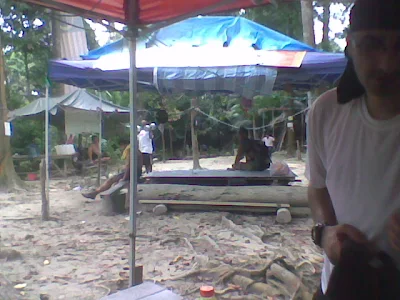If you have the time and are swatting flies like me right now, then you would have watched the whole documentary above as it appeared on the History Channel. It is a sad rendition of a piece of Malaysian history, especially towards the end of the documentary.
A few bits of juicy stories were omitted either to sanitize the icon's life or were unconfirmed hearsay. I remember that one of the first songs that he composed for a talent show during his carefree days in Caunter Hall / Kampong Rawa, Azizah, was actually penned to serenade on of his love interest then. Apparently, his love was rejected by the girl's family as he was a loafer and was hanging around the village doing nothing but singing and humming! Legend has it that Azizah later got married later and the offspring of the marriage was my form mate.
A few years ago, I had the privilege and honour of attending my alma mater's old boys' annual dinner. As P. Ramlee also attended his secondary education in Penang Free School, that year, the society decided to honour him by having the theme of the dinner based on the golden era of the Malay movie, i.e. when P. Ramlee was at the height of his career. Some of the older teachers there was describing P. Ramlee (of the cuff, course) as a student who was in his own world, singing and humming to himself all the time. Some of the teachers taught that he was off his knockers and basically 'wrote him off'. Furthermore, he was in always sitting at the back of the class in the last class of the form, disinterested in studies!
I remember reading somewhere that our hero was not really getting along well with his then wife, Junaidah. He was at the height of his career and pretty girls were around and aplenty in the the 60s, flaunting their hour glass assets in their body hugging baju kebayas. When Junaidah was gravidly pregnant with Nasir, they had a big argument. P. Ramlee uttered the dreaded word and left to stay with his then girlfriend, Mariani (Miss Singapore winner).
In the early 1970s, P. Ramlee made some social dramas for TV Malaysia. Most of them bring out the bad traits of the Malays with the hope of changing their mindset. I remember one where P Ramlee, an illiterate farmer, won the 1st prize in the now defunct National Lottery of RM 1 million. Listening to his friends and self appointed managers his whole simpleton life changed. His antics of opening a current account was so funny - He used to poke a hole in the paper as his signature! He left his village to town to start a business (what business? Import-Export! He did not know what it was but his friends told him he could make lots of money!) Then he build a house, treated all his friends, changed his wardrobe, bought a Mercedes and married a new young wife. When the time came to start his business, all his prize money had finished. At the end of the drama, he had to wind up and return to his village to continue working as a farmer.
P. Ramlee, one of my favourite performers, did what generations are trying to do in many lifetimes single-handedly in a span of 25 years till his untimely demise at the age of 44. Many of us, the 70s and 80s children, have many fond memories of watching his black and white movies shown regularly on Friday nights over RTM 1.
As always there are always a few cues to be learnt from the rise and fall of this legend. The window of opportunity is only available for a short while, the window is ajar for a short duration for us to seize and opportunity will not wait forever for us to reap. People love you when you are famous, you are infallible but the moment the fame dwindles, nobody would give you another look. Opportunists will be pouncing to bring you down, hoping to make a killing your misfortune.
Beauty and talent has a shelf life. Just like David Bowie and Madonna, stars should always re-brand themselves to move with the flow. Like many present day stars (J. Lo and Britney Spears), we should make hay when the sun is out- they diversified into fashion and perfumes. Nobody knows what is in store in our future.

Friends who laugh with you will be many but they may also laugh at you, louder, when the tide is high. Friends who cry with you are far in between but you can probably rely on your dear family when it rains on you. In the documentary above, I wonder, where these people who are shedding crocodile tears now, were when P. Ramlee was done and out.
There is no such thing as a free lunch, everything has a price. Businessmen will be businessmen. Their every action is skilfully calculated with only only one thing on their minds - profit! This commodity overpowers other virtuous virtue of humanity like compassion and unbiased sincere advice. What appears as genuine aid is actually shrouded with background ulterior motives like tax-relief! Now all of P. Ramlee intellectual property is in the hands of business tycoons.
Nasir (P Ramlee's biological son) should have been more pro-active. Having a father who succumbed to coronary events at an early age (44), he should have taken adequate precautions. But, no! He died at a reasonably young age of 56 in 2008 due to diabetes and heart disease.
Treasure your family, save for your later age when you are at the pinnacle of your career and are the prime of youth. Time and tide waits for no man.









